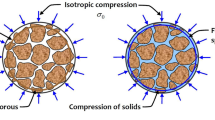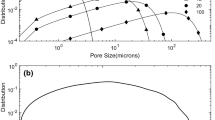Abstract
This paper derives an expression for pore pressure coefficient \(B\) in terms of a geomaterial’s mesoscopic properties and jacketed and unjacketed macroscopic compressibilities. The mesoscopic properties include phase compressibilities and pressure distribution ratios. The pressure distribution ratios represent the geomaterial’s meso-heterogeneity, while the difference between the unjacketed bulk compressibility and the solid grain compressibility represents macroscopic effects, such as solid grain rearrangement. The difference in phase compressibilities is shown to be the principal determinant of \(B\), with the effects of meso-heterogeneity and macroscopic change relatively negligible. The unjacketed pore compressibility appears to be quite sensitive to the effects of both meso-heterogeneity and macroscopic change. Although \(B\) can be derived reliably from a measured value of unjacketed pore compressibility, unjacketed pore compressibility derived from a measured value of \(B\) is considered unreliable. The expression for \(B\) includes five elastic coefficients. The necessary and sufficient condition for constant porosity in an unjacketed test is proposed. The published expressions for \(B\), the coefficient of fluid content and porosity change are recovered by introducing appropriate assumptions with regard to meso-heterogeneity and phase compressibilities.




Similar content being viewed by others
Abbreviations
- B :
-
Isotropic pore pressure coefficient
- C :
-
Full-drainage bulk compressibility
- \(C_{\text{f}}\) :
-
Compressibility of the fluid phase
- \(C_{\text{fb}}\) :
-
Firmly bonded mixture compressibility
- \(C_{\text{p}}\) :
-
Unjacketed pore compressibility
- \(C_{\text{s}}\) :
-
Compressibility of the solid phase
- \(C_{\text{nd}}\) :
-
No-drainage compressibility
- \(C_{\text{uj}}\) :
-
Unjacketed bulk compressibility
- e :
-
Volumetric strain
- \(h_{\text{f}}\) :
-
Fluid-phase pressure distribution ratio
- \(h_{\text{s}}\) :
-
Solid-phase pressure distribution ratio
- p :
-
Element’s confining pressure
- p ′ :
-
Terzaghi’s effective stress
- R :
-
Pore flux coefficient
- s :
-
Pressure acting on the solid phase
- u :
-
Pressure acting on the fluid phase
- U * :
-
Internal energy potential
- V :
-
Volume of the element
- \(V_{\text{f}}\) :
-
Volume of the fluid phase
- \(V_{\text{p}}\) :
-
Volume of the sample’s pores
- \(V_{\text{s}}\) :
-
Volume of the solid phase
- γ :
-
Coefficient of fluid content
- \(\eta\) :
-
Porosity
- ξ :
-
Seepage ratio
- \(\omega\) :
-
Pore pressure
References
Biot MA (1941) General theory of three-dimensional consolidation. J Appl Phys 12:155–165
Biot MA, Willis DG (1957) The elastic coefficients of the theory of consolidation. J Appl Mech 57-APM-44:594–601
Bishop AW (1966) Soils and soft rocks as engineering materials. Inaug Lect Imp Coll Sci Technol Lond 6:289–313
Bishop AW (1973) The influence of an undrained change in stress on the pore pressure in porous media of low compressibility. Géotechnique 23(3):435–442. https://doi.org/10.1680/geot.1973.23.3.435
Bishop AW, Eldin G (1950) Undrained triaxial tests on saturated sands and their significance in the general theory of shear strength. Géotechnique 2(1):13–32. https://doi.org/10.1680/geot.1950.2.1.13
Blöcher G, Reinsch T, Hassanzadegan A, Milsch H, Zimmermann G (2014) Direct and indirect laboratory measurements of poroelastic properties of two consolidated sandstones. Int J Rock Mech Min Sci 67:191–201. https://doi.org/10.1016/j.ijrmms.2013.08.033
Brown RJ, Korringa J (1975) On the dependence of the elastic properties of a porous rock on the compressibility of the pore fluid. Geophysics 40(4):608–616. https://doi.org/10.1190/1.1440551
De Witte AJ, Warren JE (1957) Discussion of Geertsma. Soc Pet Eng AIME 210:339–340
Gassmann F (1951) Elastic waves through a packing of spheres. Geophysics 16(4):673–685. https://doi.org/10.1190/1.1437718
Geertsma J (1957) The effect of fluid pressure decline on volumetric changes of porous rocks. Soc Pet Eng AIME 210:331–340
Green DH, Wang HF (1986) Fluid pressure response to undrained compression in saturated sedimentary rock. Geophysics 51(4):948–956. https://doi.org/10.1190/1.1442152
Hart DJ, Wang HF (2010) Variation of unjacketed pore compressibility using Gassmann’s equation and an overdetermined set of volumetric poroelastic measurements. Geophysics 75(1):9–18. https://doi.org/10.1190/1.3277664
Hill R (1963) Elastic properties of reinforced solids: some theoretical principles. J Mech Phys Solids 11(5):357–372. https://doi.org/10.1016/0022-5096(63)90036-X
Makhnenko RY, Labuz JF (2016) Elastic and inelastic deformation of fluid-saturated rock. Philos Trans R Soc A Math Phys Eng Sci 374(2078):1–22. https://doi.org/10.1098/rsta.2015.0422
Pimienta L, Fortin J, Guéguen Y (2017) New method for measuring compressibility and poroelasticity coefficients in porous and permeable rocks. J Geophys Res Solid Earth 122(4):2670–2689. https://doi.org/10.1002/2016JB013791
Reuss A (1929) Berechnung der fließgrenze von mischkristallen auf grund der plastizitätsbedingung für einkristalle. ZAMM J Appl Math Mech/Zeitschrift für Angewandte Mathematik und Mechanik 9(1):49–58. https://doi.org/10.1002/zamm.19290090104
Rice JR, Cleary MP (1976) Some basic stress diffusion solutions for fluid-saturated elastic porous media with compressible constituents. Rev Geophys 14(2):227–241. https://doi.org/10.1029/RG014i002p00227
Skempton AW (1954) The pore-pressure coefficients A and B. Géotechnique 4(4):143–147. https://doi.org/10.1680/geot.1954.4.4.143
Szalwinski CM (2019) Elasticity with a flow rule for geomaterials. Mater Today Commun. https://doi.org/10.1016/j.mtcomm.2019.100659
Tarokh A, Detournay E, Labuz J (2018) Direct measurement of the unjacketed pore modulus of porous solids. Proc R Soc A 474(2219):1–21. https://doi.org/10.1098/rspa.2018.0602
Terzaghi K (1943) Theoretical soil mechanics. Wiley, New York
Verruijt A (2005) Consolidation of soils. In: Anderson MG (ed) Encyclopedia of hydrological sciences. Wiley, New York. https://doi.org/10.1002/0470848944.hsa303
Zimmerman RW, Somerton WH, King MS (1986) Compressibility of porous rocks. J Geophys Res Solid Earth 91(B12):12765–12777. https://doi.org/10.1029/JB091iB12p12765
Zytynski M, Randolph MF, Nova R, Wroth CP (1978) On modelling the unloading-reloading behavior of soils. Int J Numer Anal Methods Geomech 2(1):87–93
Acknowledgements
The authors are grateful for the detailed comments provided by this paper's reviewers; these comments helped improve this paper considerably. The first author gratefully acknowledges the support and encouragement of Nurida Fatoullaeva. The third author acknowledges the research funding received from the Natural Sciences and Engineering Research Council (NSERC) and York University for the work described in this paper.
Author information
Authors and Affiliations
Corresponding author
Additional information
Publisher's Note
Springer Nature remains neutral with regard to jurisdictional claims in published maps and institutional affiliations.
Appendices
Appendix 1: The reciprocity relation
Consider a material that exhibits reversibility in all processes. Its response to any change in its state is independent of the path between the start and end states. Internal energy potentials exist for such material, and the internal energy associated with any given state is a scalar measure of that state. If the applied pressure and pore pressure are identified as the independent variables that define the element’s state, then the element’s volumetric strain and seepage can be expressed as partial derivatives of the element’s complementary internal energy potential, \(U^{ *} \left( {p, \omega } \right)\):
where compressive volumetric strain and inflow seepage are positive-valued.
The volumetric strain and seepage rates follow from differentiation of Eqs (66) and (67):
If \(U^{ *}\) is \(C^{2}\)-continuous in its independent variables, \(p, \omega\), Schwarz’s theorem states that its cross-derivatives are identical:
The dependent variable rates are defined as
Comparing Eqs. (68) and (69) to (71) and (72), yields
From Eqs. (70), (73) and (74),
or
The volumetric change of the fluid phase in full-drained condition is entirely due to seepage. Therefore,
Appendix 2: The comparative notations
See Table 4.
Rights and permissions
About this article
Cite this article
Szalwinski, C.M., Najma, A. & Sharma, J. Pore pressure coefficient B for saturated geomaterials with compressible, isotropic and uniform solid and fluid phases. Acta Geotech. 15, 2103–2115 (2020). https://doi.org/10.1007/s11440-020-00946-4
Received:
Accepted:
Published:
Issue Date:
DOI: https://doi.org/10.1007/s11440-020-00946-4




